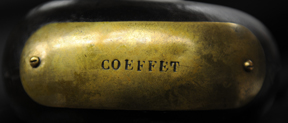
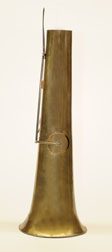
Instruments: The Ophimonocleide
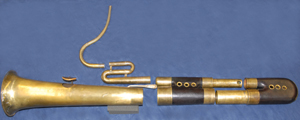
An instrument, with its one open-standing key,
that sought to solve
an intonation problem of all bass horns and serpents.
All other types of serpents and bass horns are cursed with certain identical
fingerings. Serpents in C finger these pitches, their first, second, and four harmonic notes, with all fingers closed. Unfortunately, the three accompanying lower semitones--B naturals--are fingered the same as the C and then must then be lipped down to B natural by the player. Thus, all serpentists find the intonation of B naturals compromised in the first and second octaves. The ophimoncliede was designed so that its one open-standing key (unlike all other bass horns whose keys are closed-standing) is situated near the bell at the end of the air column. By closing this key, the air column is extended, and these typically compromised notes, the B naturals, become full, vibrant, and centered well in tune.
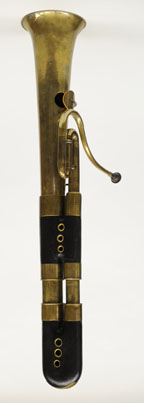

The ophimonocleide, introduced in 1828 by Jean-Baptiste Coeffet, displays the traditional characteristics of a bass horn; however, the design offered two features that addressed traditional weaknesses of upright serpents: one well-placed, open-standing key (providing the namesake for the instrument) and the most dramatic and pronounced (parallel) tuning slide permitting the greatest variation in pitch of any upright serpent.
DIMENSIONS: forthcoming
Measurements of air column with the instrument pitched at A=440
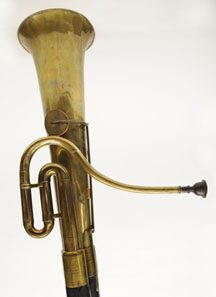

text by Craig Kridel
Please note: many images and museum displays of the ophimoncleide depict the bocal in an unplayable position. This position is the correct configuration.
One important designation among all upright serpents is the configuration of finger holes for the lengthening of the air column. Using Mendelssohn's 1824 line drawing of the English bass horn (sent in a letter to his sister, Fanny), finger holes have been placed in order on the air column as a way to display their positioning for the ophimonocleide.

Such an airhole design creates a series of cross-fingerings (with the 5th fingerhole) that alters the standard lengthening of the aircolumn. Some instruments include a split entry into aircolum for the 4th fingerhole.
Clearly, the ophimonocleide is an experimental instrument that addressed many of the perennial problems of bass horns.

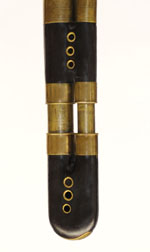
A pompe, a double slide, enables the pitch to be altered from "opera" pitch to "cathedral" pitch. In fact, lengthening the pompe and bocal permits the instrument to be raise or lowered a minor third. Such variations alter completely the fingering patterns.
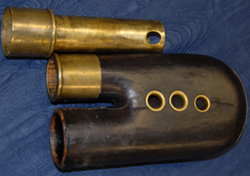
The ophimonocleide was patented by
Jean-Baptiste Coeffet of Chaumont-en-Vexin, Oise, on May 2, 1828.
Forthcoming:
to download a high density image of an ophimonocleide
Please include the following photo credit
in any public presentation:
© Craig Kridel,
Berlioz Historical Brass
For a further description of the different types of bass horns, see
Bass horns and Russian bassoons
by Craig Kridel
exploring the role of
early 19th century brass
Piccolo Press : ITEA Historical Instrument Section : The Tigers Shout Band : Harmoniemusik : Links
